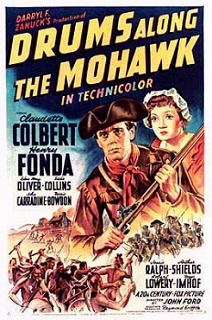In the movie, Henry Fonda played pioneer settler Gil Martin, with Claudette Colbert as his wife Magdalena "Lana" Martin.
The plot was based on an historical novel of the American Revolution written by Walter D. Edmonds. Published in 1936 and extremely popular, it was made into a film in 1939.
The setting is the Mohawk River Valley during the American Revolution, which was subjected to numerous raids by the British, American Tories, and their Iroquois allies. Included in both works is a fictitious representation of the siege of Fort Stanwix.
Indians appear in three contexts in Drums. Let's look at them:
Blue Back: An Indian stands in a cabin doorway lit in red and announced by a thunderclap. Scary stuff, but this Indian turns out to be one of the good guys.
True, Blue Back's characterization is far from perfect. He's there mainly for comic relief. Perhaps the worst part is how he speaks like a stereotypical Tonto:
On the other hand, he has an authentic-sounding name, not a phony one like "Soaring Eagle" or "Brave Bear." And he's a Christian ("As good a Christian as you or me," says Gil). Making him a Christian rather than a "noble savage" who speaks airily of the Great Spirit is an atypical choice.
Moreover, Blue Back apparently kills the British agent Caldwell at the end. He speaks a line in a Native language, perhaps Mohawk. And he's played by someone who seems to be an Indian: Chief Big Tree.
The pair of Indians who attack Mrs. McKlennar: Two Indians invade the widow's bedroom while she's in bed. "Burn house fire quick," says one of them, while the other drinks from a jug.
McKlennar berates them as they set the room on fire and refuses to abandon her heirloom bed. "Filthy drunken rascal," she labels one of them, and "crazy horse thieves." She's so forceful that she cows the pair into submission. Rather than harm her, they save her, carrying her and the bed to safety.
Again, we see a mix of stereotypes and non-stereotypes. The Indians begin as drunken savages but redeem themselves by acting humanely. They're not pure evil.
The rest of the Indians: Hordes of Indians whoop and burn the settlers' homes. They attack the fort and when they catch a scout, they crucify and burn him alive. These Indians have no individuality; they're a savage mass of destruction.
The settlers treat them thusly with a series of epithets:
The one saving grace is that they're shown following the British agent's orders at least once. This implicitly acknowledges that the Indians weren't just rampaging because it was their nature. No, they allied themselves with the Americans or the British for strategic reasons. They shrewdly calculated where the advantage lay and acted accordingly.
I also credit the movie for its extended anti-war scene. Lana waits desperately for Gil to appear as a line of injured, weary soldiers straggles by. When Gil finally shows up, he talks about how warfare is so much worse than one imagines. A roomful of injured veterans, one of whom requires amputation, reinforces the point. It's a remarkable bit considering this movie was made in the run-up to World War II.
Overall, I liked Drums better than the similar The Last of the Mohicans. Its portrayal of Indians isn't as bad as some of the Westerns I've seen. Rob's rating: 8.0 of 10.


No comments:
Post a Comment
Note: Only a member of this blog may post a comment.